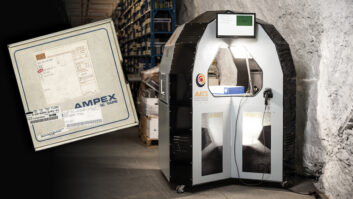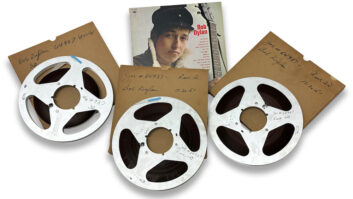Welcome to another thrilling installment of This Old Tape Machine. Today’s deck du jour is the Alesis ADAT. As always, the mission is to familiarize users with “device normality” before disaster strikes. Too often, I receive frantic e-mails about stuck tapes or machines clearly displaying error messages — reason enough to take the machine in for service — yet, somehow the message doesn’t get through. Don’t punch in on a digital multitrack that is regularly suffering from a lunar influence.
For most tape machines, a #2 Phillips screwdriver should be used for the cover screws. Figure 1 shows the most common mistake: An undersized driver can damage both the screw and the driver tip. Figure 1 also shows the necessary “snug” fit. Do not use damaged tips. Buy good tools once and treat them well. So it won’t slip out, firmly press the driver into the screw. Some screws are so tight that a wimpy grip can cause damage.
With the exception of the M20, all Alesis transports are essentially the same. For the original “black face” model, access is obvious. The cover and main circuit board are secured with SAE-type screws — referenced to the American (Society of Automotive Engineers) system of measurement. The top cover screws are number “6-32,” six being the diameter designation with 32 threads per inch. The transport is foreign-built — its screws have ISO metric threads. Don’t mix ’em up. Pay attention, and you’ll see the different thread pitches. Put loose screws in a clean tray, bowl or coffee cup. For XT, XT-20 and LX-20, remove the cover and the rack ear screws.
Assuming that the machine is functional, the tape should smoothly thread around the rotating head assembly (aka, the “drum”) with no excess slack anywhere. Sloppiness around the drum is a sign of poor brake calibration. On the right is the rubber pinch roller and chrome capstan shaft. These parts govern the tape speed. Inside the cassette shell are two “reels” that sit on the mechanism’s “reel tables.” If tape starts to fill up in the transport area, then either the pinch roller is not disengaging (see “A La Mode”) or the take-up reel table is not moving (see “Fast-Wind”).
CLEAN, CLEAN, CLEAN!
Hopefully, you’re familiar with manual head cleaning — a simple procedure with the ADAT. Figure 2 shows how to apply an alcohol-dampened cloth to the side of the head drum. (I use Twillwipes from Chemtronics, with either 99% alcohol or denatured alcohol. These are slow-drying, environmentally friendly chemicals — compared to some rather toxic alternatives from the past — so allow at least five minutes of drying time.) While holding the cloth in place, rotate the drum counterclockwise. You may feel the four tiny head chips under the cloth as the drum is turned. Do not move the cloth in any direction, except to place it against the drum or to remove it. If the cloth gets dirty, then alternate from wet to dry until you are satisfied. End with a dry cloth. And just like in ye olde analog daze, use a standard cotton swab to clean the linear head located just before the capstan shaft.
Inspect and clean all rubber parts — pinch roller, reel table idler (Fig. 3, tire color will vary), and the thin, “motion-sensing” belt on the take-up reel table. Use water-based cleaners like Windex, Fantastic or Formula 409. Do not use alcohol or any other cleaner designated for use on rubber parts except those sold via www.athan.com — they make pinch rollers, so their cleaner is the safest. The idler tire sub assembly is the most common ADAT wear item. On the black face, the tire was originally black-mounted on white plastic. New versions are cream-colored “Santoprene” on baby-blue plastic. (I sure know a lot about babies now!) For XT, XT-20 and LX-20, the Santoprene is on a smaller diameter, white plastic hub. It cleans up pretty well with a water-based cleaner, only if no “rubber” cleaners have ever been used.
Rubber parts that can be accessed from the top of the machine include the pinch roller, reversing idler, motion belt and load belt. The capstan and thread belts are accessed from the ADAT’s underside. The idler should be regularly cleaned and replaced more often than the others. It’s best to order a complete rubber kit with extra idlers. (See “Under New Management.”)
FAST-WIND
If your fast-wind is not very fast, check both reel tables for vertical play, as indicated by the orange arrow in Fig. 4a. If there is no movement, press down on the top (double yellow arrows) until a “pop” is felt. This might get you through a session, but the table should be replaced. XT owners should check the supply-side reel table for the spring and pad, designated by the yellow arrows in Fig. 4b. This spring should be removed; however, any changes to the reel tables will necessitate a brake re-calibration (see sidebar).
A LA MODE
Strange, inconsistent behavior can be traced to the Mode switch, which reports transport status to the microprocessor. On all models (except the M20), this is a black, plastic switch located on the underside of the transport near the take-up brake solenoid. The black face, XT and XT-20 allow easy access to this area, the LX does not. If the machine goes for long periods without use, or has not had routine service, then the Mode switch will most likely act up the first time a tape is inserted. Always start with a non-critical tape and cycle through the modes — insert & eject, play & stop, stop/threaded, stop/unthreaded and fast-wind. As a short-term solution, repeat these cycles to self-clean the switch, but replace ASAP.
DRY WEATHER WOES
During cold, dry weather, static electricity can plague many products. If you’ve got an old black face or XT, then check Fig. 5 and note the ground wire highlighted by the blue arrow (wire color may vary). The symptom is “random stopping for no apparent reason.” Static electricity is generated as the capstan belt runs from motor to flywheel and back; the occasional spark is misinterpreted as a Stop command. This flat belt is clearly visible from the underside of all models but the LX. The added wire attaches from the motor case to ground (pin 2 in the photo).
ERROR-7
Error-7 messages typically indicate a condition such as dirty rotary heads or defective/low-quality tapes with excessive dropouts. However, error messages don’t always translate into one obvious problem. For example, XT, XT-20, LX and M20 users should pay attention to the error rate (Press Set, Locate & Record Enable-3). If your ADAT displays block error rates in the 3,000 range, then this can indicate a failed head preamp (rather than an actual “head” problem) and may be a likely cause of Error-7 displays. The head drum has four head “chips” (two for record, two for playback) mated with a preamp IC called the RP1. Not all shops have the expertise to disassemble the head assembly and replace the IC, so prices vary. I prefer not to mate a price for each ailment, because most machines need “routine maintenance” anyway; most service ballparks at $250 to $350, unless a new head assembly or other major parts are needed.
UNDER NEW MANAGEMENT
Earlier this year, Numark owner Jack O’Donnell purchased Alesis. At the time of this writing, the company is moving forward and restructuring is still going on. By the time this issue hits the stands, the dust should have settled. Contact www.alesis.com and www.advancedmusical.com for official press releases and parts availability, respectively.
Eddie Ciletti maintains a comprehensive list of tape machine tips at his Website: www.tangible-technology.com.
ADAT BRAKE CALIBRATION CHECK FOR LX AND XT SERIES RECORDERS
If your ADAT indicates “CAl brAC,” what do you do? “CAl brAC” stands for “calibrate brakes.” Like any motorized vehicle, brakes need to be adjusted from time to time. Brake calibration on XT and LX models is accomplished through software and does not require a trip to a service center. Follow the 7-step procedure below.
- Use a standard ST-120 (40-minute) tape that has been completely formatted from beginning to end. Use a non-essential tape. Do not use ST-180 or ST-60 lengths.
- With the power off, press Rewind and Fast Forward during power-up. The display will read “CALIbrAt.” (For the LX, power must be applied from the cable.)
- Insert the formatted ST-120 tape into the transport. The XT or LX will then fast forward the tape to the end and begin its routine.
- The XT or LX will shuttle the tape back and forth for about five minutes. During this procedure, the tape will half-eject twice. This is normal.
- Assuming the tape, the reel motor and the brake solenoids are operational, the display should briefly read “PaSS” before fully ejecting the tape and returning to the Start Up screen. If so, then the brakes have now been re-calibrated.
- If the “CAl brAC” message re-appears, check operation with another tape. If the message persists, then the unit must be professionally serviced.
- If the brake calibration fails, then it’s service time.
Failure to pass brake calibration indicates trouble with one or more of the following items: the brake solenoids (located under the reel tables); the reel tables (if popped); the motion-sensing belt; the idler tire; or the reel motor and/or its driver circuitry, especially if the reel tables have popped and error messages are ignored.
— Eddie Ciletti







